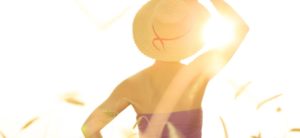- Ultraviolet A, the part of the sunlight ultraviolet spectrum primarily responsible for skin aging, is not blocked by most window glass. This is why people who spend a lot of time sitting in their car without sunblock or special window tinting can develop facial aging that is worse on one side. Broad-spectrum sunscreens, especially mineral physical blockers like zinc and titanium, can effectively shield you from these rays. If you have a long commute home in the afternoon sun, remember to reapply your sunscreen before you hop in your car. One suggestion for sunscreen touch-up is Colorescience brush-on zinc powder, which works well as a protective coat over makeup. Also, consider getting a UVA tint professionally applied to your car windows if you spend a lot of time driving, especially in our high altitude Denver, Colorado sun.
- Spray-on sunscreens need to be rubbed into the skin to get the full SPF protection. I’ve witnessed too many times people simply misting their skin with sunscreen spray. If not rubbed in, the mist forms small droplets of sunscreen over only a small fraction of the total skin surface area. New formulations are available that are also easy to apply and spread in a clear layer without the risk of inhaling the obnoxious fumes or spraying your downwind neighbor. For example, a zinc based sunscreen mousse by Bare Republic is available for larger areas like trunk, arms and legs, and it is also easy to spread over hairy areas.
- Two chemical sunscreen ingredients, oxybenzone and octinoxate, were recently banned in Hawaii because they may be harmful to coral reefs. However, there is no known harm to reef systems caused by mineral sunscreens containing zinc or titanium. An even better option is to wear a sun protective rash guard or swim shirt and cover only small exposed areas with sunscreen. You will thank yourself later when you don’t end up spending precious vacation days nursing a painful burn.
- Living in Denver, Colorado increases our ultraviolet exposure by as much as 30% over sea level. For every 1000 ft elevation gain, there is approximately 4-6% increased ultraviolet intensity. If you are one who enjoys skiing and hiking that intensity can easily double at high altitudes. Also, snow reflects up to an additional 80% of the ultraviolet right back onto your skin. Therefore, sun protection is even more critical in these settings.
- There is no such thing as waterproof sunscreen. The FDA has mandated that sunscreens are labelled either water resistant to 40 or 80 minutes. Sunscreens cannot claim to be “waterproof”. All sunscreens will wear off faster with water exposure, and it’s important to remember that you can get burned through the water. I recommend “Sport” formulations for anybody planning on swimming or sweating when outdoors. These formulations will be water resistant up to 80 minutes and are specially formulated to stay on the skin under physically active conditions. Reapplication every hour while under these conditions is important.
- Damage to the DNA in your skin cells starts within minutes of ultraviolet exposure. DNA damage is mostly due to UVB rays and occurs immediately, especially at high altitude in Denver, Colorado. Fortunately, our bodies have mechanisms to repair some, but not all, DNA damage with our own DNA repair enzyme. Excessive damage, particularly the amount that causes sunburn, can overwhelm our natural defenses and lead to enough DNA damage to cause skin cancer. Even cumulative daily sun exposure – those 5-10 minutes getting in and out of your car – adds up over time and is shown to lead to increased rates of skin cancer later in life. For all these reasons, it is best to wear a sunscreen with at least SPF 30 everyday.
- UPF, which stands for ultraviolet protection factor, is the rating system used for sun protective clothing. A UPF of 50 means that 1/50th of the ultraviolet rays get through the clothing. For comparison, a regular white T-shirt has a UPF of 8. UPF rated clothing uses special light weight, tightly woven fabrics to shield the sun’s rays. Covering up is always going to be your safest bet in shielding your skin from the sun. Remember wide-brimmed hats to help protect your face, eyes, neck, and ears.
- Skin sensitivity to sunscreen is usually caused by a chemical sunscreen ingredient. Chemical sunscreens absorb at least partially into the skin and can cause irritant or even allergic skin reactions. Also, chemical sunscreens function by absorbing ultraviolet light – this leads to a chemical reaction that generates heat. This is why you may sometimes experience warmth, redness, or stinging while in the sun with a chemical sunscreen. Sensitive skin types should stick to mineral based sunscreens with zinc, titanium or both.
- Most people under-apply sunscreen. Applying 50% of the recommended amount of sunscreen reduces the SPF to 25% of the normal value. Sun protection factor (SPF) of a sunscreen is determined under laboratory conditions where skin is covered with 2 mg/cm2 of sunscreen and exposed to an ultraviolet source that simulates sun exposure. SPF 40 means that it takes 40 times as long to burn than would occur without sunscreen — BUT this is in the controlled environment of a lab. In real life situations, studies show that most people do not even apply 1/2 as much sunscreen as the SPF controlled studies. Additionally, most people do not reapply sunscreen every 1-2 hours as recommended. With decreased sunscreen application, the SPF drops off dramatically — it is not a direct, linear relationship. Therefore, when 1/2 the normal amount his used, the protection is actually only about 25%, or SPF 10 for an SPF 40 labeled sunscreen.
9 Facts about sun protection you may not realize


